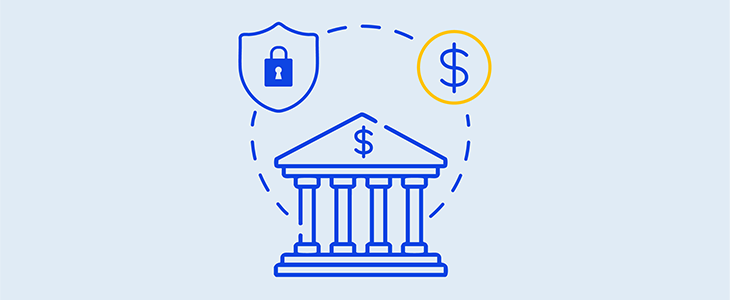What Is a Share Secured Loan, and How Does It Work?

Summary
A share secured loan is a personal loan backed by funds in your savings account. Find out how it works, who it’s for and alternatives to consider before applying.
In this article:
If you have a large upcoming expense, like a car repair or home improvement project, you may be looking for ways to borrow money without using up your savings. A share secured loan, sometimes called a passbook loan or savings-secured loan, is one option you might consider.
Let’s take a closer look at what a share secured loan is and how it may help you, especially if you want to build your credit.
What is a share secured loan?
Offered by some lenders — mostly credit unions and small banks — a share secured loan is a type of secured loan that’s backed by collateral, in this case, your savings or CD account balance.1 You may request to borrow up to the amount of money you have in a savings account with the bank or credit union, then pay it back in installments like other personal loan products.
How does a share secured loan work?
If you’re approved for a share secured loan, the lender provides you with the money and puts a hold on the amount in your account that’s equivalent to the borrowed amount. You won’t have access to the funds on hold in your account until you repay your loan partially or fully, depending on your loan agreement.2 Your funds continue to earn interest even with the hold on them.3
Lenders generally let you pay back your loan through authorized automatic withdrawals from another account or by check. If you default — meaning you don’t repay according to the terms of your loan — the lender may take the savings that were placed on hold from your account to make up for their losses.4
As you pay back your loan on time each month, you may build a positive credit history. However, if you fail to make your payments for at least 30 days, the lender may report your late payments to the three major credit bureaus (Experian, TransUnion and Equifax).5 Late payments may cause your credit score to decrease.
If you have less-than-perfect credit, a share secured loan might be worth exploring because, as a depositor with the bank or credit union, you may be able to avoid a credit check to qualify.6
Reasons to take out a share secured loan
A share secured loan might make sense for you for several reasons:
- You hope to build or improve your credit with minimal risk: Payment history is an important factor in calculating your credit score. Making payments on-time builds your credit history, which can help increase your score. An improved credit score might make it easier to qualify for other loans or lines of credit with lower interest rates and more favorable terms in the future.
- You’d like to qualify for a loan with a limited credit history: Share secured loans typically don’t require a credit check, so you may qualify even if you have a limited credit history.
- You want to build your credit by making on-time payments: A share secured loan could help you get used to making timely payments and borrowing responsibly without depleting the savings you worked so hard to build.
Costs and benefits of a share secured loan
A share secured loan could be a smart way to help you build credit, but as with any loan, it’s important to weigh the costs and benefits. Let’s dive deeper to help you decide if a share secured loan is the right move for your financial goals.
Pros
- Potentially lower interest rates: Secured loans, including share secured loans, typically offer lower interest rates than unsecured loans, which don’t require collateral. A lower interest rate could also reduce your overall cost of borrowing.7
- Easy qualification requirements: A share secured loan usually doesn’t involve a credit check, which may lead to a faster and easier qualification process.
- Chance to build or improve credit: The lender reports your on-time payments to the three major credit bureaus, which could open the door to more financing options and better interest rates down the road.
Cons
- Frozen funds in your savings account: The lender will likely put a hold on an amount equal to what you’ve borrowed. You won’t be able to access the held funds in your savings account until you pay back your loan in part or in full, depending on the terms of your agreement.
- May lose money: A share secured loan uses your savings account as collateral. If you can’t make your payments, you might lose the money you’ve saved.
- Potential credit issues: Late or missed payments as well as a loan default could cause your credit score to decrease, which could make it harder to get approved for a new loan or line of credit down the line.
When might a share secured loan make sense?
While a share secured loan could be a good fit for some people, it may not be right for everyone. Consider your situation and financial goals before you take one out.
A share secured loan may work for you if you:
- Want to build or rebuild credit: A share secured loan could improve your credit score if you make timely payments every month.
- Have savings you could use as collateral: To take out a share secured loan, you’ll need money in a savings account.
- Are looking for a low-interest loan: Since a share secured loan uses your savings account as collateral,reducing the risk to the lender, you may be able to land a lower interest rate.
- Need to show creditworthiness for future borrowing: If you repay your loan on time, a share secured loan could help position you as a responsible borrower when you apply for a mortgage or auto loan.
A share secured loan may not work for you if you:
- Don’t have enough savings to use as collateral: Each lender has its own requirements, but if you don’t have enough money in a qualifying savings account, a share secured loan might not be an option for you.
- Already qualify for other loan options: If you have a strong credit score and could get approved for a loan with more favorable terms, a share secured loan might not make sense.
- Need access to your savings: When you apply for a shared secured loan, the lender freezes a portion of your savings account for collateral. You won’t have access to that portion of your savings during the loan period.
Alternatives to share secured loans
Before you commit to a share secured loan, consider these alternative funding options.
Secured personal loan
A secured personal loan is a lump sum you receive upfront and repay over time with interest. You back a secured personal loan with collateral, or something valuable that you possess, like a car. A secured loan often gives you access to a lower interest rate, a lower monthly payment or a higher borrowing amount. Plus, lenders like OneMain offer you fixed interest rates and predictable payments to make it easier for you to budget your other monthly expenses. However, keep in mind that if you don’t make payments according to your loan agreement, the lender can take your collateral to recoup their costs.
Unsecured personal loan
Unsecured personal loans also give you a lump sum that you repay with interest, but they do not require collateral. You may need to meet stricter eligibility requirements, like a higher credit score or income, but if you qualify for an unsecured loan, you won’t risk losing your collateral if you can’t make loan payments. OneMain also offers unsecured personal loans. They work with a wide range of customer credit scores and take your whole financial picture into account to help you find the loan that’s right for you.
Credit-builder loan
Specifically designed for borrowers who want to build their credit, a credit-builder loan is when a lender, bank or credit union deposits the amount you want to borrow into a dedicated savings account. Unlike a shared secure loan, you don’t need savings to get started, but you won’t have access to the funds you borrowed right away. If you make timely repayments and the lender reports them to the credit bureaus, your credit score may improve. Once you pay back your loan, you’ll have access to the money minus interest and fees.
Secured credit card
A secured credit card is like a general-purpose credit card, except you provide a cash deposit to open the account, which also acts as your credit limit. You might use a secured credit card to make everyday purchases, like groceries, gas or your morning coffee, and repay the balance each month. If you miss a payment or don’t pay off your entire balance, you’ll be charged interest. If you continue to miss payments and default, the credit card issuer may take your deposit to cover the cost.
As you make payments on time each month and show the card issuer that you’re a responsible borrower, your secured card could get upgraded to an unsecured credit card.8
Power up your credit with your savings
A share secured loan is typically considered to be a low-risk, accessible way to establish credit or borrow conservatively. However, before you move forward, make sure the lender will report your payments to the credit bureaus so that you can build your credit profile. Carefully consider the loan terms and explore alternative options to make an informed decision about your situation.
Sources:
1,3,7 https://www.bankrate.com/loans/personal-loans/passbook-loans
2,4,5,6 https://www.creditkarma.com/personal-loans/i/share-secured-loan
8 https://www.investopedia.com/terms/s/securedcard.asp
This article is for general education and informational purposes, without any express or implied warranty of any kind, including warranties of accuracy, completeness, or fitness for any purpose and is not intended to be and does not constitute financial, legal, tax, or any other advice. Parties (other than sponsored partners of OneMain Financial (OMF)) referenced in the article are not sponsors of, do not endorse, and are not otherwise affiliated with OMF.


